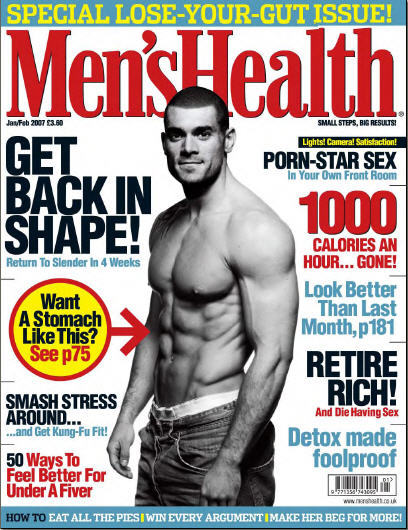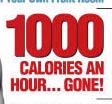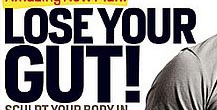Tyler Rankin's Final Project
The Body and Masculine Identity

The inspection of the three magazine covers reveal that the masculine body is closely tied up
to all other aspects of male identity. The title of the magazine is "Men's Health", and the
field of health generally refers to bodily health (this is including mental health as part of
the body). As a result, the primary focus of the magazine is on the manipulation of the male body
into "health", although this health is often only referring to weight loss and other issues which
relate to a healthy appearance, and is far less concerned with other aspects of true health, such
as proper nutrition, disease issues and mental health. As previously stated, the cover models are
meant to be a picture of the ideal masculine body. These images, much like most other magazine
images, are airbrushed and "photoshopped", and present an overly-idealized masculine form, which
readers are asked to, but seldom able to, emulate. There are a number of similar traits between
the three depictions of the models, and the similarities can be seen as specific examples of the
ideal masculine body. Firstly, each model is positioned in such a way that the chest, arms, and
shoulders appear bigger, and it would seem that the models' upper body muscles are indeed big.
The emphasis on upper body strength has long been a part of masculine discourse, and can be related
to ideas of power, strength, and the ability for conquest.A strong upper body is often related to
strength in physical confrontation, although, as Yvonne Tusker notes, this is only in Western
discourse on male strength in combat, East Asian ideas on ideal masculine strength is quite
different from our own (Tusker 73).


The models demonstrate toned, muscular bodies, with an emphasis on the size of the muscles.
The pictures seem to illustrate the ideal that most of the captions are discussing. Of the total
captions, approximately half of them deal with "health?" and the ideal masculine body. The emphasis
of the captions is primarily cosmetic, and encourage the readers to "burn fat" and "build muscle".
Muscularity seems to be the main concern of the magazine's ideas on male health, and the loss of
fat can primarily be seen as a way to emphasize this muscularity. This coincides with Dotson's
statement that "the emphasis [in such magazines] is not health, but being attractive to women" and
that "heterosexual men believe heterosexual women find male muscles important," regardless of the
facts. Muscularity and the ideal male physique is intimately entwined with ideas about sexual
desirability, and such ideas lead male readers to overly connect ideas about bodily shape with a
quality, healthy sex life.


Muscularity is not only associated with virility and desirability, but also with power and potency.
Tasker again states that "the visibility of the built male body represents part of a wider shift
in the male image." Tasker's study is mainly concerned with the male image in action films, and
demonstrates that muscularity is associated with the power and violence of contemporary Hollywood
action cinema. This muscularity is associated with the violent power often exhibited by an action
movie star, and this body image coincides with the textual evidence of violence in male discourse
which is demonstrated by the captions. The idealized male body is also associated with social power
and economic affluence. The fact that 1 of the models is a famous movie star, and that many of the
cover models for "Men's Health" often are, further demonstrates the idea that a strong male body is
necessary for strong economic and social influence, or "power." Another way in which the idealized
masculine body is seen as a form of economic influence is through consumerism. Several of the "Men's
Health" articles on weight-loss or other body issues feature sections on the "best gear", consumer
products which the reader is encouraged to buy in order to help them achieve ideal manhood. These
products are often expensive, and exploit male insecurities and societal discourse on masculinity
in order to increase consumption and turn a profit. Kenon Breazeale?s article states that
historically, such "'lifestyle' features service advertisers by transforming [the] reader into
consumer" (Breazeale 232). In this way, consumerism and ideal masculinity are directly related.
Go to final page
Back 


